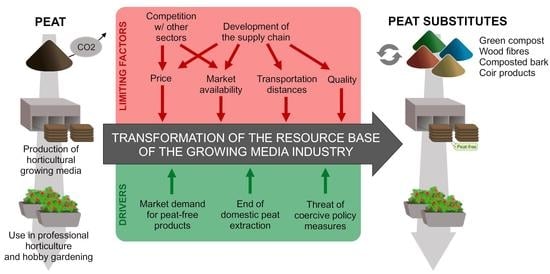Peat Substitution in Horticulture: Interviews with German Growing Media Producers on the Transformation of the Resource Base
Abstract
:1. Introduction
2. Materials and Methods
2.1. General Method
2.2. Sampling
2.3. Questionnaires and Interviews
2.4. Qualitative Analysis
2.5. Interest and Position of the Interviewees
3. Results
3.1. Description of the Sample
3.1.1. Company Characteristics
3.1.2. Supply and Processing of Growing Media Constituents
3.1.3. Position on the Peat Use Reduction Strategy
3.2. Challenges and Requirements of the Growing Media Sector
3.2.1. Products Requirements for Final Use
3.2.2. Price of Materials
3.2.3. Transportation
3.2.4. Reliability of the Supply
3.2.5. Internal Storage and Processing Capacities
3.2.6. Political and Long-Term Situation
3.3. Assessment of Materials
3.4. Assessment of the Transformation
3.4.1. The “Availability Problem” as a Future Challenge
3.4.2. Current Limiting Factors of the Transformation
3.4.3. Current Drivers of the Transformation
3.4.4. Transformation in a Competitive Framework
3.5. Specific Situation of 2022
4. Discussion
4.1. Validity of Preliminarily Calculated Potentials
4.2. Future Evolution of Transformation Factors
4.3. Implication for the Peat Use Reduction Strategy
4.4. Conclusions and Further Research
Author Contributions
Funding
Data Availability Statement
Acknowledgments
Conflicts of Interest
Appendix A
| Question | Type of Question/Choices | |
|---|---|---|
| 1 | Name: | Open field |
| 2 | Company: | Open field |
| 3 | E-mail: | Open field |
| 4 | Is your company member of the Industrieverband Garten e.V. (IVG)? | Yes/No |
| 5 | How many employees are working in your company in the growing media sector in Germany? | Multiple choice: (a) 1–5 (b) 6–10 (c) 11–20 (d) 21–50 (e) 51–100 (f) 101–200 (g) more than 200 |
| 6 | Is the growing media production the main activity of you company in Germany? | Yes/No |
| 7 | How much growing media do you produce annually in Germany?
| For each: Open field |
| 8 | What is the average peat rate in your growing media?
| For each, multiple choice: (a) 0–5% (b) 5–20% (c) 20–40% (d) 40–60% (e) 60–80% (f) 80–100% |
| 9 | Where are your production facilities located in Germany? | For each site: Open field |
| 10 | Does your company have own peat extraction sites? | Yes/No |
| 10b | (If yes) where are they located? | Multiple answer: (a) In Germany (b) Outside Germany |
| 11 | Does your company have the goal to increase the use of peat alternatives in growing media? | Yes/No |
| 12 | Please indicate in case your company has quantified or timely defined goals on peat reduction or increase of use of peat alternatives | Open field |
| 13 | The strategy of the Ministry of Food and Agriculture aims to end the use of peat in Germany in the hobby sector by 2026 and to reduce it to the greatest extent in the professional sector. What is the position of you company regarding these goals? | Multiple choice: (a) Very favourable (b) Rather favourable (c) Neutral (d) Rather unfavourable (e) Very unfavourable |
| 14 | You can further explain the position of your company here: | Open field |
| 15 | Do you have additional commentaries? | Open field |
| Step | Content/Questions |
|---|---|
| Introduction | Presentation of the interviewer Presentation of the project Presentation of the background including preliminary research on potentials Presentation of the research question Do you have any commentaries or question? |
| Clarifying questions | Questions related to the questionnaire, especially definition for growing media in the statistics |
| Supply and processing chain | Growing media constituents used Own processing or not Supply chain of materials Distance from suppliers Type of suppliers Relationship to supplier / contracts |
| Challenges linked to the constituents | Challenges linked to the availability and the use of constituents Reasons to reduce peat use |
| Closed question 1 | “For which materials do you see the strongest difficulties for your company to increase the use for growing media production?” Ranking: (a) wood fibres and wood products (b) composted bark and bark products (c) green compost (d) coir products |
| Closed question 2 | “In the case the demand only consists of peat-free products in 2030, how would you evaluate the possibility for your company to only produce peat-free at the same production level?” Multiple choice: (a) It would be absolutely not possible (b) It would be only possible with strong changes of the current conditions (c) It would be possible but problematic in the current conditions (d) It would be rather unproblematic in the current conditions (e) We are already completely peat-free |
| Closing discussion | What would be the solutions to the challenges mentioned regarding the reduction of peat use? Who would be responsible for implementing these solutions? Are there things that we did not mention in the interview and that would be worth mentioning? |
References
- Secretariat of the United Nations Framework Convention on Climate Change. Greenhouse Gas Inventory Data—Peat Extraction. Flexible Queries Annex I Countries. Available online: https://di.unfccc.int/flex_annex1 (accessed on 6 May 2022).
- Peano, L.; Loerincik, Y.; Margni, M.; Rossi, V. Comparative Life Cycle Assessment of Horticultural Growing Media Based on peat and Other Growing Media Constituents: Final Report. 2012. Available online: https://warumtorf.kundenprojekt.info/fileadmin/user_upload/comparative-life-cycle-assessment-of-horticultural-growing-media-based-on-peat-and-other-growing-media-constituents.pdf (accessed on 30 May 2022).
- Stucki, M.; Wettstein, S.; Mathis, A.; Amrein, S. Erweiterung der Studie «Torf und Torfersatzprodukte im Vergleich»: Eigenschaften, Verfügbarkeit, Ökologische Nachhaltigkeit und Soziale Auswirkungen, Wädenswil; ZHAW Zürcher Hochschule für Angewandte Wissenschaften: Winterthur, Switzerland, 2019. [Google Scholar] [CrossRef]
- Lindholm, T.; Heikkilä, R. Destruction of mires in Finland. In The Finnish Environment [Online]; Finnish environment Institute: Helsinki, Finland, 2006; pp. 179–192. Available online: https://www.researchgate.net/publication/261070498_Destruction_of_mires_in_Finland (accessed on 26 July 2023).
- Hirschler, O.; Osterburg, B. Peat extraction, trade and use in Europe: A material flow analysis. Mires Peat 2022, 28, 1–27. [Google Scholar] [CrossRef]
- Schmatzler, E. Die Torfindustrie in Niedersachsen—Ergebnisse einer Umfrage zur Zukunft der Torfgewinnung in Niedersachsen. TELMA-Berichte der Deutschen Gesellschaft für Moor-und Torfkunde 2012, 42, 27–42. [Google Scholar]
- Caspers, G.; Schmatzler, E. Vorkommen und Verwendung von Torf in Deutschland. TELMA Beiheft zu den Berichten der Deutschen Gesellschaft für Moor-und Torfkunde 2009, 39, 75–98. [Google Scholar]
- Secretariat of the United Nations Framework Convention on Climate Change. Adoption of the Paris Agreement. I: Proposal by the President (Draft Decision); United Nations Office: Geneva, Switzerland, 2015. [Google Scholar]
- Parish, F.; Sirin, A.; Charman, D.; Joosten, H.; Minayeva, T.; Silvius, M.; Stringer, L. Assessment on Peatlands, Biodiversity and Climate Change: Main Report; Global Environment Centre: Kuala Lumpur, Malaysia; Wetland International: Wageningen, The Netherland, 2008; ISBN 978-983-43751-0-2. [Google Scholar]
- Leifeld, J.; Menichetti, L. The underappreciated potential of peatlands in global climate change mitigation strategies. Nat. Commun. 2018, 9, 1071. [Google Scholar] [CrossRef] [Green Version]
- Joosten, H.; Tapio-Biström, M.-L.; Tol, S. Peatlands—Guidance for Climate Change Mitigation through Conservation, Rehabilitation and Sustainable Use, 2nd ed.; Food and Agriculture Organization of the United Nations: Rome, Italy, 2012; ISBN 978-92-5-107302-5. [Google Scholar]
- Prasad, M. Review of the Use of Peat Moss in Horticulture: Final Report of the Chairman of the Working Group. 2021. Available online: https://assets.gov.ie/213283/b110a6f6-bebf-4496-9c76-92f3cf0faf35.pdf (accessed on 26 July 2023).
- Gruda, N. Advances in Horticultural Soilless Culture; Burleigh Dodds Science Publishing Limited: Cambridge UK, 2020; ISBN 9781003048206. [Google Scholar]
- Gruda, N. Sustainable peat alternative growing media. Acta Hortic. 2012, 927, 973–979. [Google Scholar] [CrossRef]
- Gruda, N.S. Current and Future Perspective of Growing Media in Europe. Acta Hortic. 2012, 960, 37–43. [Google Scholar] [CrossRef]
- Schmilewski, G. Producing growing media responsibly to help sustain horticulture. Acta Hortic. 2014, 1034, 299–306. [Google Scholar] [CrossRef]
- Gruda, N.S. Advances in Soilless Culture and Growing Media in Today’s Horticulture—An Editorial. Agronomy 2022, 12, 2773. [Google Scholar] [CrossRef]
- Savvas, D.; Gruda, N. Application of soilless culture technologies in the modern greenhouse industry—A review. Europ.J.Hortic.Sci. 2018, 83, 280–293. [Google Scholar] [CrossRef]
- Federal Ministry for the Environment, Nature Conservation, Building and Nuclear Safety. Climate Action Plan 2050: Principles and Goals of the German Government’s Climate Policy. 2016. Available online: https://www.bmuv.de/fileadmin/Daten_BMU/Pools/Broschueren/klimaschutzplan_2050_en_bf.pdf (accessed on 15 June 2023).
- Federal Ministry of Food and Agriculture. Going Peat-Free, Protecting the Climate: The Peat Use Reduction Strategy of the Federal Ministry of Food and Agriculture. 2022. Available online: https://www.bmel.de/SharedDocs/Downloads/EN/Publications/peat-use-reduction-strategy.pdf?__blob=publicationFile&v=6 (accessed on 9 June 2023).
- UK Government. England Peat Action Plan. 2021. Available online: https://assets.publishing.service.gov.uk/government/uploads/system/uploads/attachment_data/file/1010786/england-peat-action-plan.pdf (accessed on 26 July 2023).
- Federal Council of Switzerland. Bericht des Bundesrates in Erfüllung des Postulats 10.3377 Diener Lenz «Torfausstiegskonzept». 2012. Available online: https://www.newsd.admin.ch/newsd/message/attachments/29089.pdf (accessed on 26 July 2023).
- Norwegian Ministry of Climate and Environment. Norway’s Climate Action Plan for 2021–2030: Meld. St. 13 (2020–2021) Report to the Storting (White Paper). 2022. Available online: https://www.regjeringen.no/contentassets/a78ecf5ad2344fa5ae4a394412ef8975/en-gb/pdfs/stm202020210013000engpdfs.pdf (accessed on 9 June 2023).
- Ministry of Agriculture, Nature and Food Quality; Ministry of Economic Affairs and Climate Policy; Netherlands Association of Potting Soil and Substrate Manufacturers; Netherlands Agricultural and Horticultural Association; Greenhouse Horticulture Netherlands; Plantum; Tuinbranche Nederland; Dutch Association of Biowaste Processors; Dutch Association of Wholesalers in Floricultural Products; Dutch Flower Auctions Association; et al. Covenant on the Environmental Impact of Potting Soil and Substrates. 2022. Available online: https://turfvrij.nl/wp-content/uploads/2023/02/Convenant-english.pdf (accessed on 9 June 2023).
- Bundesministerium für Landwirtschaft, Regionen und Tourismus. Moorstrategie Österreich 2030+. 2022. Available online: https://info.bml.gv.at/dam/jcr:b1db9395-5df4-4863-8d3b-f0d97b83cc67/Moorstrategie%20%C3%96sterreich%202030+.pdf (accessed on 9 June 2023).
- Hirschler, O.; Osterburg, B.; Weimar, H.; Glasenapp, S.; Ohmes, M.-F. Peat Replacement in Horticultural Growing Media: Availability of Bio-Based Alternative Materials: Thünen Working Paper 190; Thünen Working Paper; Johann Heinrich von Thünen Institute: Braunschweig, Germany, 2022. [Google Scholar] [CrossRef]
- Gruda, N.S.; Hirschler, O.; Stuart, J. Peat reduction in horticulture—An overview of Europe. Acta Hortic. 2023; in print. [Google Scholar]
- Council of the European Union. Agriculture and Fisheries Council. 24 May 2022. Available online: https://www.consilium.europa.eu/en/meetings/agrifish/2022/05/24/ (accessed on 9 June 2023).
- Regulation (EU) 2018/841 of the European Parliament and of the Council of 30 May 2018 on the Inclusion of Greenhouse gas Emissions and Removals from Land Use, Land Use Change and Forestry in the 2030 Climate and Energy Framework, and Amending Regulation (EU) No 525/2013 and Decision No 529/2013/EU (Text with EEA Relevance); O.J. (L 156) 1; European Union: Maastricht, The Netherlands, 2018.
- Growing Media Europe. The Role of Peat in Growing Media. Available online: https://www.growing-media.eu/peat (accessed on 9 June 2023).
- Schmilewski, G. Growing media constituents used in the EU in 2013. Acta Horticulturae 2017, 1168, 85–92. [Google Scholar] [CrossRef]
- Regulation (EU) 2019/1009 of the European Parliament and of the Concil of 5 June 2019 Laying Down Rules on the Making Available on the Market of EU Fertilising Products and Amending Regulations (EC) No 1069/2009 and (EC) No 1107/2009 and Repealing Regulation (EC) No 2003/2003 (Text with EEA Relevance); O.J. (L 170) 1; European Union: Maastricht, The Netherlands, 2019.
- Industrieverband Garten e.V. 2020–2023 Data on (1) Use of Constituents for Growing Media for the Domestic Market, (2) Production of Growing Media and (3) Peat Extraction and Imports; Presentation and Documents. Personal communication.
- Blok, C.; Eveleens, B.; van Winkel, A. Growing media for food and quality of life in the period 2020–2050. Acta Hortic. 2021, 1305, 341–356. [Google Scholar] [CrossRef]
- Schmilewski, G. Growing medium constituents used in the EU. Acta Hortic. 2009, 819, 33–46. [Google Scholar] [CrossRef]
- Martins, T.; Machado, R.; Alves-Pereira, I.; Ferreira, R.; Gruda, N. Coir-Based Growing Media with Municipal Compost and Biochar and Their Impacts on Growth and Some Quality Parameters in Lettuce Seedlings. Horticulturae 2023, 9, 105. [Google Scholar] [CrossRef]
- Barrett, G.E.; Alexander, P.D.; Robinson, J.S.; Bragg, N.C. Achieving environmentally sustainable growing media for soilless plant cultivation systems—A review. Sci. Hortic. 2016, 212, 220–234. [Google Scholar] [CrossRef] [Green Version]
- Neumaier, D.; Meinken, E. Peat substitutes in growing media—Options and limitations. Acta Hortic. 2015, 1099, 159–166. [Google Scholar] [CrossRef]
- Gruda, N. Increasing Sustainability of Growing Media Constituents and Stand-Alone Substrates in Soilless Culture Systems. Agronomy 2019, 9, 298. [Google Scholar] [CrossRef] [Green Version]
- Schmilewski, G. Kultursubstrate und Blumenerden—Eigenschaften; Ausgangsstoffe, Verwendung, Industrieverband Garten e.V., Düsseldorf, Germany. 2018. Available online: https://substratbuch.ivg.org/static/flipbook/flipbook.html (accessed on 26 July 2023).
- Carlile, W.R.; Cattivello, C.; Zaccheo, P. Organic Growing Media: Constituents and Properties. Vadose Zone J. 2015, 14, vzj2014.09.0125. [Google Scholar] [CrossRef]
- Laun, N.; Weinheimer, S.; Lutz, F.; Emmel, M.; Gruda, N. Peat reduced substrates for vegetable seedlings. Acta Hortic. 2021, 1321, 23–30. [Google Scholar] [CrossRef]
- Gruda, N.S.; Fernández, J.A. Optimising Soilless Culture Systems and Alternative Growing Media to Current Used Materials. Horticulturae 2022, 8, 292. [Google Scholar] [CrossRef]
- Muro, J.; Irigoyen, I.; Samitier, P.; Mazuela, P.; Salas, M.C.; Soler, J. Wood Fiber as Growing Medium in Hydroponic Crop. Acta Hortic. 2005, 697, 179–185. [Google Scholar] [CrossRef]
- Jackson, B.E.; Wright, R.D. Pine tree substrate: An alternative and renewable substrate for horticultural crop production. Acta Hortic. 2009, 819, 265–272. [Google Scholar] [CrossRef]
- Woznicki, T.; Kusnierek, K.; Sønsteby, A. Performance of wood fibre as a substrate in hydroponic strawberry production under different fertigation strategies. Acta Hortic. 2021, 1309, 289–296. [Google Scholar] [CrossRef]
- Beretta, D.; Ripamonti, M. Evaluation of wood fiber as component of substrates for container nursery crops. Acta Hortic. 2021, 1305, 77–82. [Google Scholar] [CrossRef]
- Machado, R.M.A.; Alves-Pereira, I.; Ferreira, R.; Gruda, N.S. Coir, an Alternative to Peat—Effects on Plant Growth, Phytochemical Accumulation, and Antioxidant Power of Spinach. Horticulturae 2021, 7, 127. [Google Scholar] [CrossRef]
- Gaudig, G.; Krebs, M.; Prager, A.; Wichmann, S.; Barney, M.; Caporn, S.J.M.; Emmel, M.; Fritz, C.; Graf, M.; Grobe, A.; et al. Sphagnum farming from species selection to the production of growing media: A review. Mires Peat 2018, 20, 1–30. [Google Scholar] [CrossRef]
- Vandecasteele, B.; Muylle, H.; de Windt, I.; van Acker, J.; Ameloot, N.; Moreaux, K.; Coucke, P.; Debode, J. Plant fibers for renewable growing media: Potential of defibration, acidification or inoculation with biocontrol fungi to reduce the N drawdown and plant pathogens. J. Clean. Prod. 2018, 203, 1143–1154. [Google Scholar] [CrossRef]
- Nguyen, T.H. Miscanthus as Primary Feedstock for Growing Media in Soilless Cultivation. Ph.D. Dissertation, University of Bonn, Bonn, Germany, 2022. [Google Scholar]
- Dittrich, C.; Pecenka, R.; Løes, A.-K.; Cáceres, R.; Conroy, J.; Rayns, F.; Schmutz, U.; Kir, A.; Kruggel-Emden, H. Extrusion of Different Plants into Fibre for Peat Replacement in Growing Media: Adjustment of Parameters to Achieve Satisfactory Physical Fibre-Properties. Agronomy 2021, 11, 1185. [Google Scholar] [CrossRef]
- Both, A.K.; Helle, M.A.; Madireddy, G.; Cheung, C.L. Green Chemical Approach to Fabricate Hemp Fiber Composites for Making Sustainable Hydroponic Growth Media. ACS Agric. Sci. Technol. 2021, 1, 499–506. [Google Scholar] [CrossRef]
- Prasad, M.; Chrysargyris, A.; McDaniel, N.; Kavanagh, A.; Gruda, N.S.; Tzortzakis, N. Plant Nutrient Availability and pH of Biochars and Their Fractions, with the Possible Use as a Component in a Growing Media. Agronomy 2020, 10, 10. [Google Scholar] [CrossRef] [Green Version]
- Crippa, L.; Zaccheo, P.; Orfeo, D. Utilization of the solid fraction of digestate from anaerobic digestion as container media substrate. Acta Hortic. 2013, 367–373. [Google Scholar] [CrossRef]
- Restrepo, A.P.; Medina, E.; Pérez-Espinosa, A.; Agulló, E.; Bustamante, M.A.; Mininni, C.; Bernal, M.P.; Moral, R. Substitution of Peat in Horticultural Seedlings: Suitability of Digestate-Derived Compost from Cattle Manure and Maize Silage Codigestion. Commun. Soil Sci. Plant Anal. 2013, 44, 668–677. [Google Scholar] [CrossRef]
- Industrieverband Garten e.V. Selbstverpflichtung der Substratindustrie zur Torfminderung, Düsseldorf, Germany. 2020. Available online: https://www.ivg.org/fileadmin/downloads/Torfminderung/IVG_Selbstverpflichtung_Torfminderung_Kurzversion.pdf (accessed on 15 June 2023).
- Zentralverband Gartenbau e.V.; Verband Deutscher Garten-Center e.V. Empfehlung zur Torfminderung, Berlin, Germany. 2022. Available online: https://www.derdeutschegartenbau.de/wp-content/uploads/2022/08/2022_03_zvg_vdg_torfminderung.pdf (accessed on 14 June 2023).
- Fachagentur Nachwachsende Rohstoffe e.V. TerZ—Torfersatz im Zierpflanzenbau. Available online: https://torfersatz.fnr.de/torfersatz/forschung-zu-torfersatz-im-gartenbau/torfersatz-im-zierpflanzenbau (accessed on 26 July 2023).
- Fachagentur Nachwachsende Rohstoffe e.V. ToSBa—Torfersatz in Baumschulen: Modell- und Demonstrationsvorhaben zur Praxiseinführung von torfreduzierten Substraten in Baumschulen. Available online: https://torfersatz.fnr.de/torfersatz/forschung-zu-torfersatz-im-gartenbau/torfersatz-in-baumschulen (accessed on 14 June 2023).
- Witzel, A. Das problemzentrierte Interview. In Qualitative Forschung in der Psychologie: Grundfragen, Verfahrensweisen, Anwendungsfelder; Jüttemann, G., Ed.; Beltz: Weinheim, Germany, 1985; pp. 227–255. ISBN 978-3-407-54680-7. [Google Scholar]
- Braun, V.; Clarke, V. Thematic analysis. In APA Handbook of Research Methods in Psychology, Vol 2: Research Designs: Quantitative, Qualitative, Neuropsychological, and Biological; Cooper, H., Camic, P.M., Long, D.L., Panter, A.T., Rindskopf, D., Sher, K.J., Eds.; American Psychological Association: Washington, DC, USA, 2012; pp. 57–71. ISBN 1-4338-1005-0. [Google Scholar]
- Statistisches Bundesamt. GENESIS-Online, Tabelle 42271-0002: Beschäftigte und Umsatz der Betriebe im Verarbeitenden Gewerbe: Deutschland, Jahre, Wirtschaftszweige (WZ2008 2-/3-/4-Steller). Kategorie “Torfgewinnung”. Available online: https://www-genesis.destatis.de/genesis/online (accessed on 14 June 2023).
- Herbes, C.; Lohr, D. Torffreier Hobbygartenbau bis 2026—Herausforderungen und Lösungsansätze (HOT): Konsument*innen-Wahrnehmungen und pflanzenbauliche Realität. Presentation at FNR Workshop Torminderung – eine Branche im Wandel, Online. 21 March 2023; Available online: https://veranstaltungen.fnr.de/torfminderung-eine-branche-im-wandel/rueckblick/rueckblick-21-maerz-2023 (accessed on 26 July 2023).
- Wichmann, S.; Krebs, M.; Kumar, S.; Gaudig, G. Paludiculture on former bog grassland: Profitability of Sphagnum farming in North West Germany. Mires Peat 2020, 26, 1–18. [Google Scholar] [CrossRef]


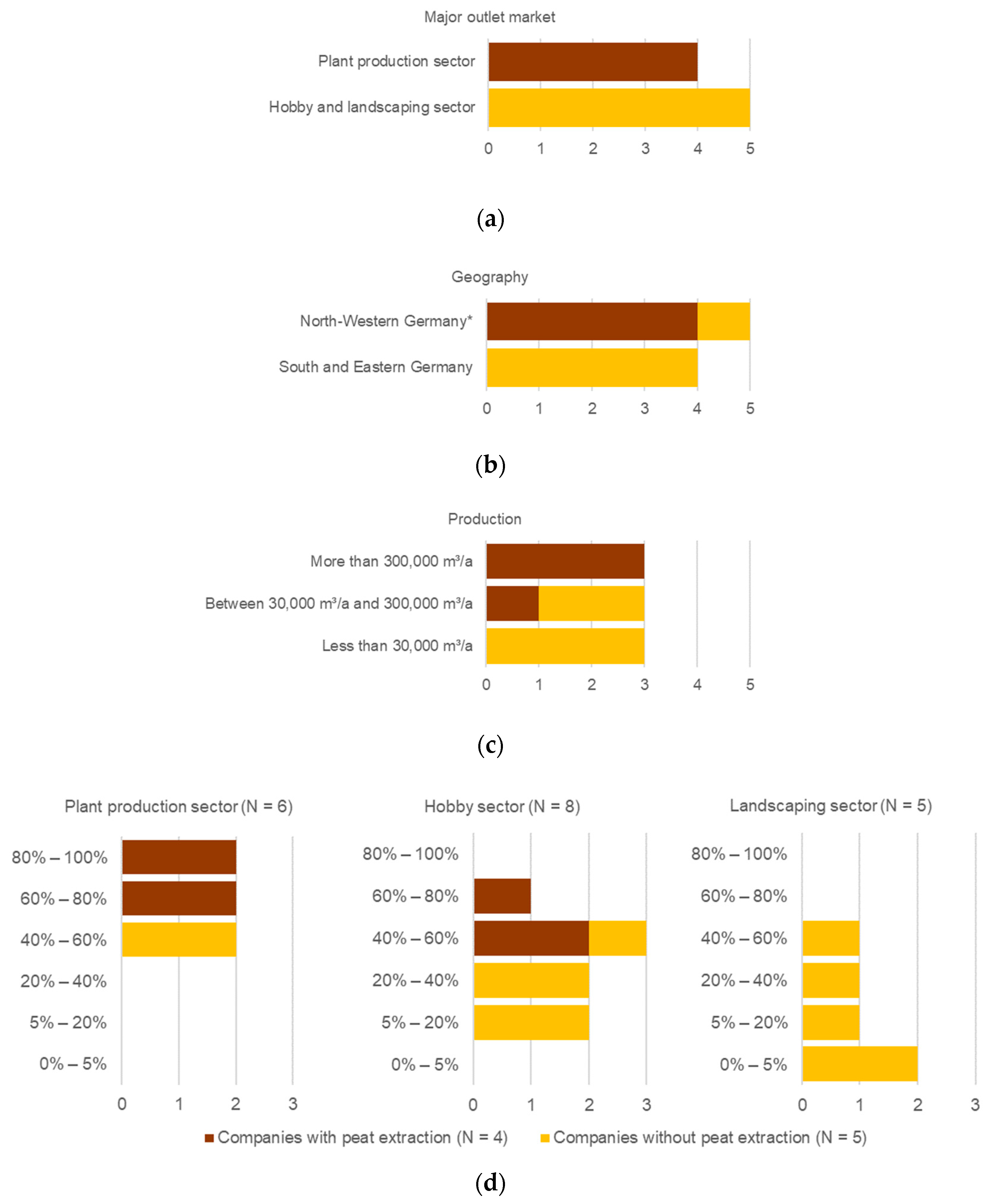
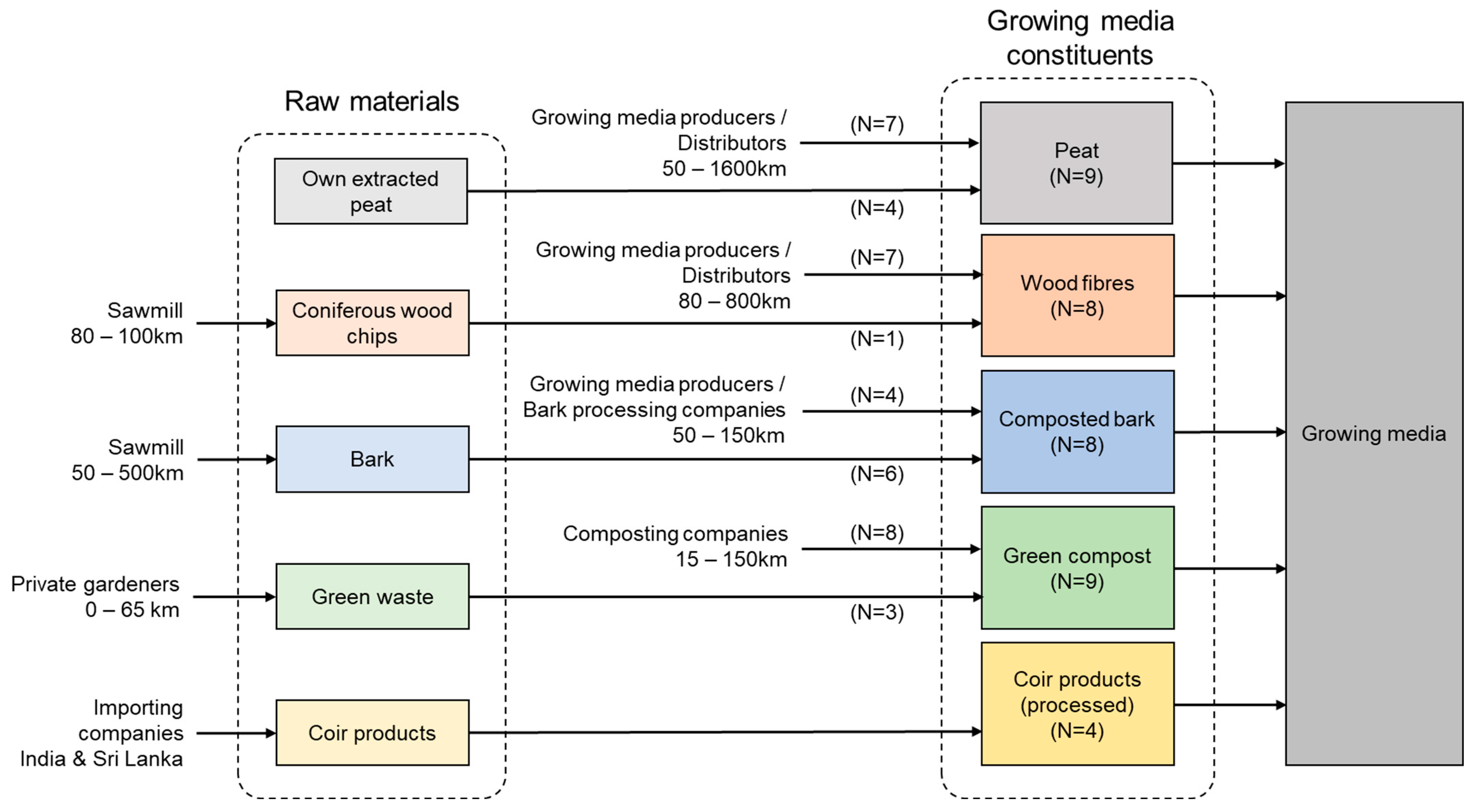
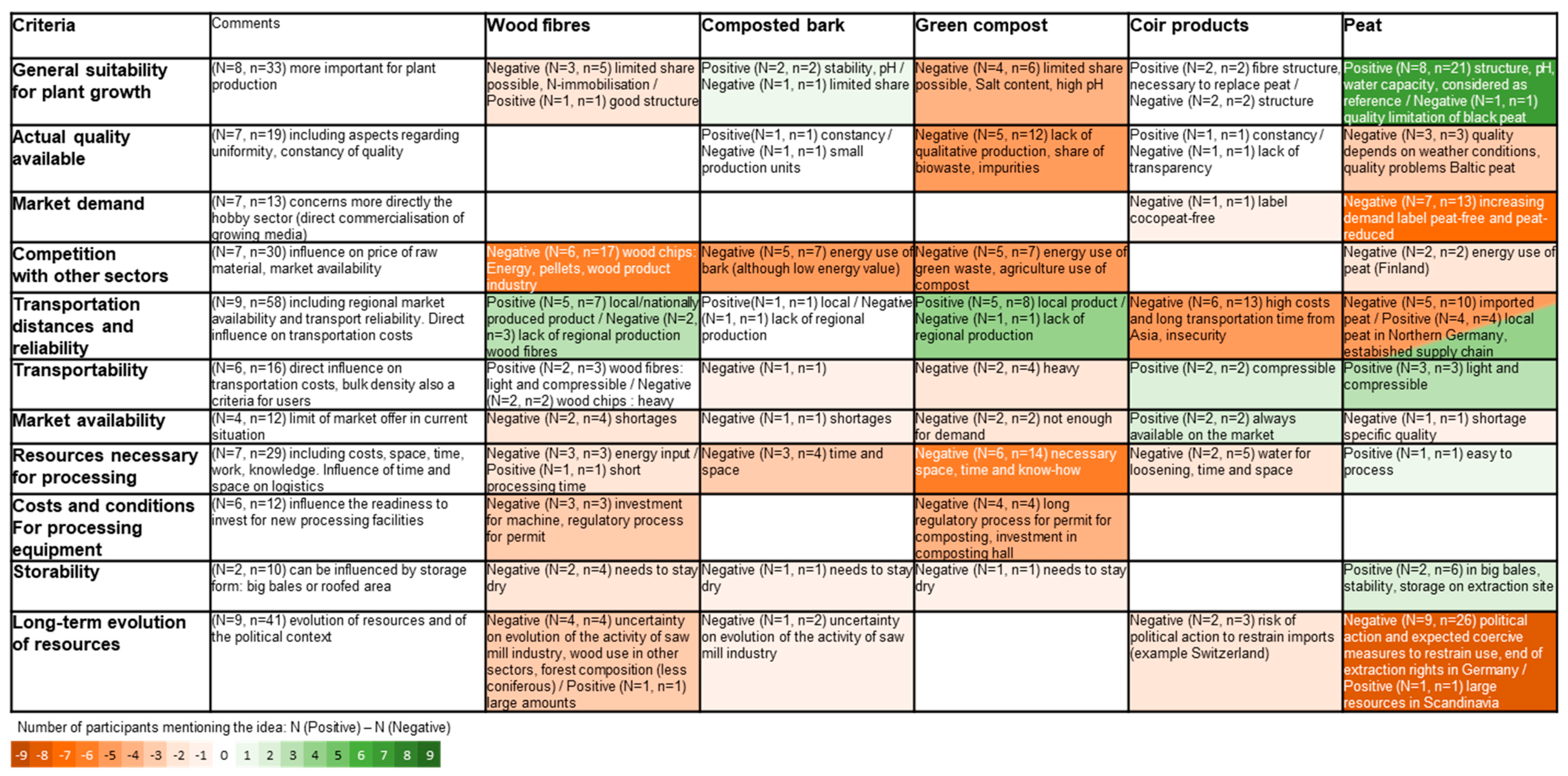
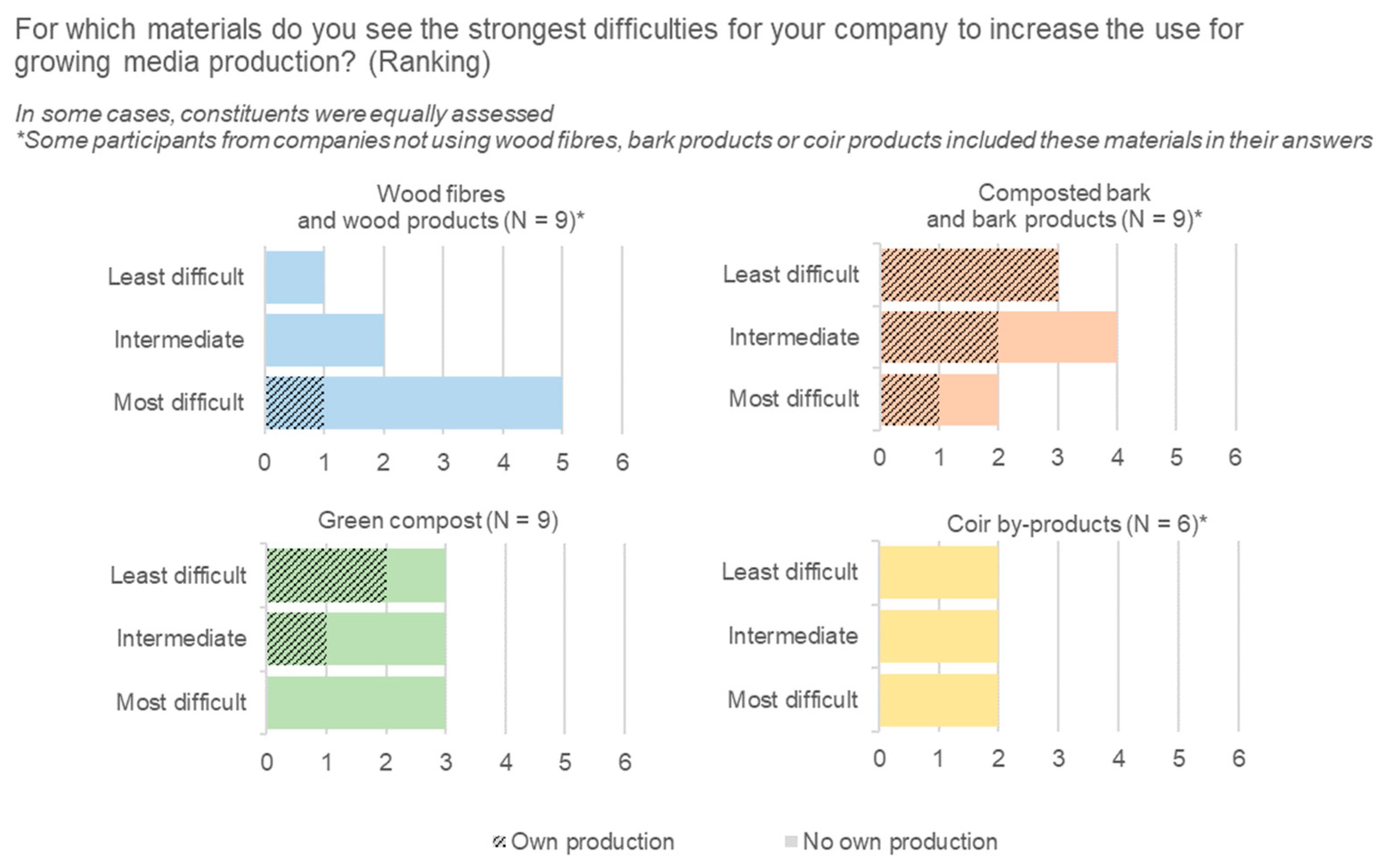
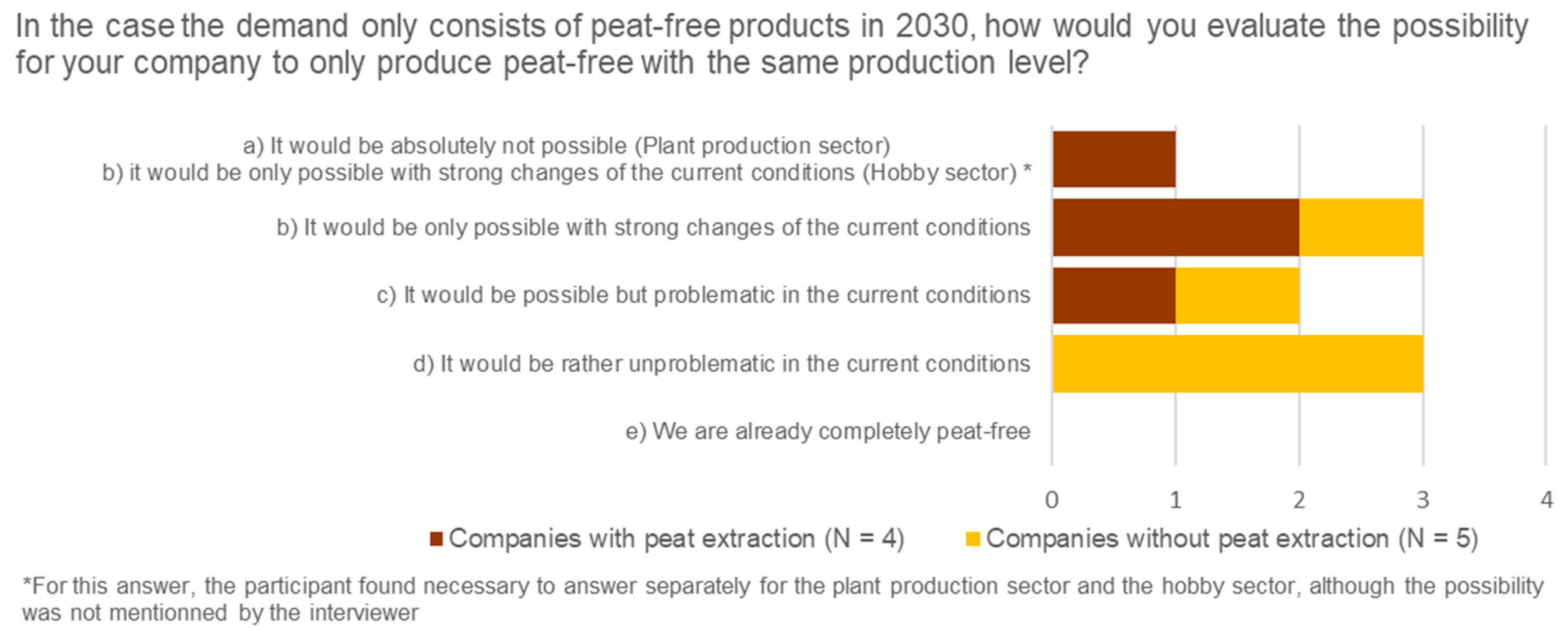

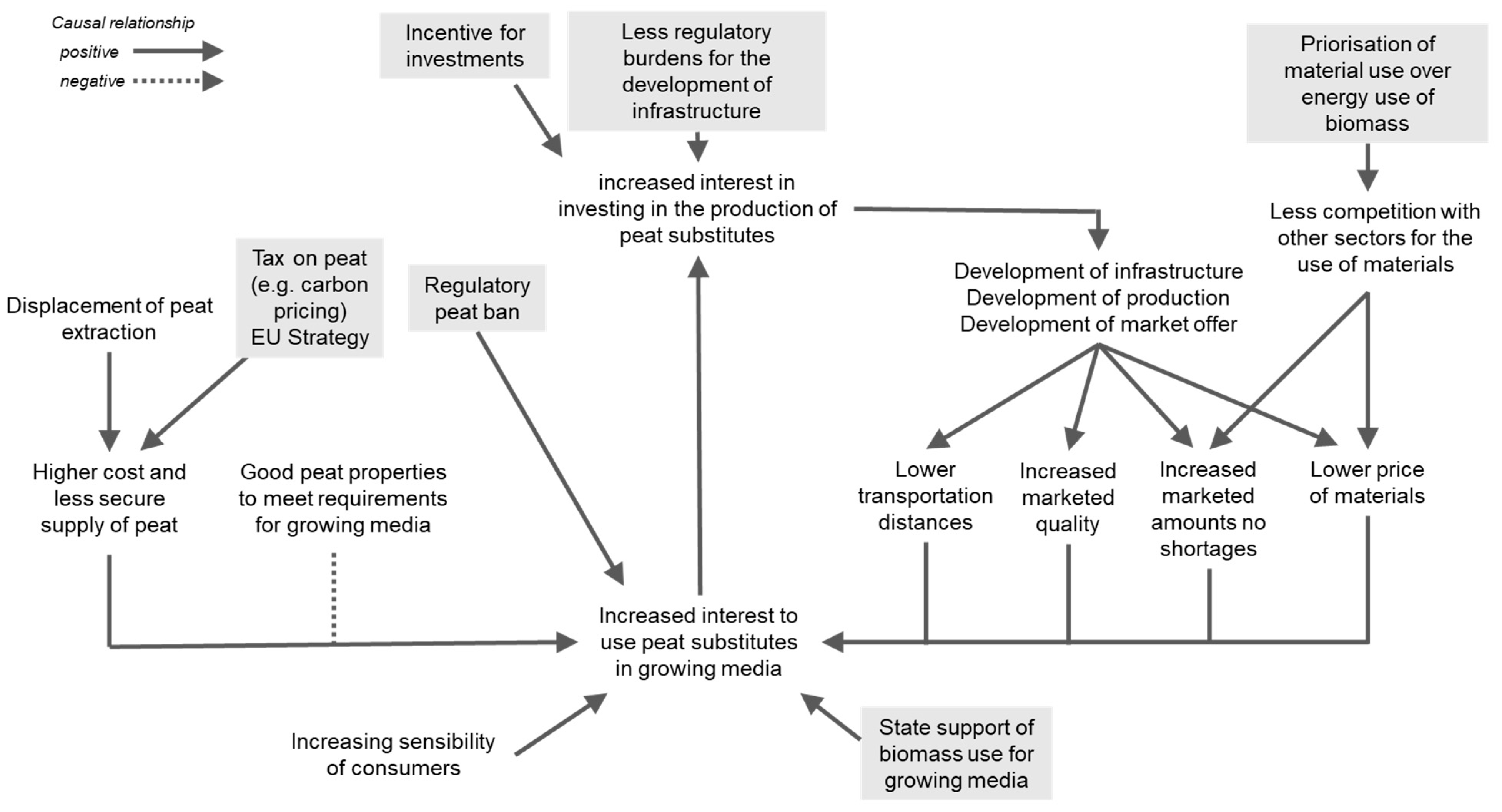
| Sample | German Industry | |
|---|---|---|
| Total companies | 9 | 83 |
| Total growing media production (m3/a) * | 3.15 × 106 | 8.1 × 106 |
| Average growing media production per company * (m3/a) | 350,550 m3 | 97,590 m3 |
| Number of companies above 20 employees * | 56% (5/9) | 29% (24 **/83) |
| Number of companies with majority of production in North-Western Germany * | 56% (5/9) | 48% (40/83) |
Disclaimer/Publisher’s Note: The statements, opinions and data contained in all publications are solely those of the individual author(s) and contributor(s) and not of MDPI and/or the editor(s). MDPI and/or the editor(s) disclaim responsibility for any injury to people or property resulting from any ideas, methods, instructions or products referred to in the content. |
© 2023 by the authors. Licensee MDPI, Basel, Switzerland. This article is an open access article distributed under the terms and conditions of the Creative Commons Attribution (CC BY) license (https://creativecommons.org/licenses/by/4.0/).
Share and Cite
Hirschler, O.; Thrän, D. Peat Substitution in Horticulture: Interviews with German Growing Media Producers on the Transformation of the Resource Base. Horticulturae 2023, 9, 919. https://doi.org/10.3390/horticulturae9080919
Hirschler O, Thrän D. Peat Substitution in Horticulture: Interviews with German Growing Media Producers on the Transformation of the Resource Base. Horticulturae. 2023; 9(8):919. https://doi.org/10.3390/horticulturae9080919
Chicago/Turabian StyleHirschler, Olivier, and Daniela Thrän. 2023. "Peat Substitution in Horticulture: Interviews with German Growing Media Producers on the Transformation of the Resource Base" Horticulturae 9, no. 8: 919. https://doi.org/10.3390/horticulturae9080919
APA StyleHirschler, O., & Thrän, D. (2023). Peat Substitution in Horticulture: Interviews with German Growing Media Producers on the Transformation of the Resource Base. Horticulturae, 9(8), 919. https://doi.org/10.3390/horticulturae9080919






